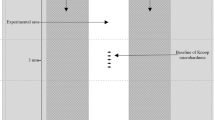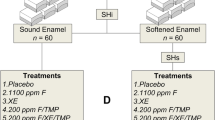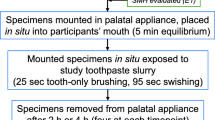Abstract
Objective
This five-phase, single-blind, crossover in situ trial evaluated the effects of desensitizing or anti-erosive toothpastes on dentin erosive wear and tubule occlusion.
Materials and methods
Some characteristics such as relative dentin abrasivity (RDA), viscosity (V), cytotoxicity, and fluoride and calcium (Ca) availability of the toothpastes were also tested. Samples were positioned on removable intraoral appliances from 15 volunteers (n=4), according to the groups, C-control (0 ppm fluoride), F-sodium monofluorophosphate (MFP), A-MFP and arginine+calcium carbonate, CSP-calcium sodium phosphosilicate, and CS-MFP and calcium silicate+sodium phosphate. Erosion-abrasion cycling was performed (1% citric acid, 2min, 6×/day; toothbrushing, 5s, 2×/day). Surface loss (SL) was evaluated by optical profilometry. Environmental scanning electron microscopy images (ESEM) counted the number of open dentin tubules (ODTs). Data were statistically analyzed (α=0.05).
Results
There were no significant differences in SL among groups (p=0.468). The ODT for CSP, CS, and A groups were significantly lower than the control. CSP and CS presented significantly less ODT than F, but they did not significantly differ from A. F and CS were more abrasive than all the other toothpastes; CSP was more abrasive than A, and C was the least abrasive. CSP presented higher V (p<0.05). All toothpastes presented lower cell viability than the control without toothpaste exposure. F and A presented significantly higher values of F- (p<0.05). All fluoride toothpastes had similar amount of Ca, differing from the control (p<0.05).
Conclusion
Although the toothpastes caused similar degree of erosive wear, CSP and CS were able to occlude the dentin tubules.
Clinical relevance
Desensitizing toothpastes containing calcium, sodium, phosphate, and silicate could be a suitable option for treating dentin hypersensitivity.




Similar content being viewed by others
Change history
31 May 2021
Incorrect tagging of author name.
References
Lussi A, Schlueter N, Rakhmatullina E, Ganss C (2011) Dental erosion - an overview with emphasis on chemical and histopathological aspects. Caries Res 45:2–12
Lussi A, Carvalho TS (2014) Erosive tooth wear: a multifactorial condition of growing concern and increasing knowledge. Monogr Oral Sci 25:1–15. https://doi.org/10.1159/000360380
West N, Seong J, Davies M (2014) Dentine hypersensitivity. Monogr Oral Sci 25:108–22
Recommendations C, Hypersensitivity D, Canadian Advisory Board on Dentin Hypersensitivity (2003) Consensus-based recommendations for the diagnosis and management of dentin hypersensitivity. J Can Dent Assoc 69:221–226
Absi EG, Addy M, Adams D (1992) Dentine hypersensitivity--the effect of toothbrushing and dietary compounds on dentine in vitro: an SEM study. J Oral Rehabil 19:101–110
Naylor F, Corrêaaranha AC, Eduardo CDP, Arana-Chavez VE, Sobral MAP (2006) Micromorphological analysis of dentinal structure after irradiation with Nd:YAG laser and immersion in acidic beverages. Photomed Laser Surg 24:745–752. https://doi.org/10.1089/pho.2006.24.745
Magalhães AC, Wiegand A, Honório HM et al (2009) Insights into preventive measures for dental erosion. J Appl Oral Sci 17:75–86. https://doi.org/10.1590/S1678-77572009000200002
Schmidlin PR, Sahrmann P (2013) Current management of dentin hypersensitivity. Clin Oral Investig 17:55–59. https://doi.org/10.1007/s00784-012-0912-0
Pinto SCS, Bandéca MC, Pinheiro MC et al (2014) Preventive effect of a high fluoride toothpaste and arginine-carbonate toothpaste on dentinal tubules exposure followed by acid challenge: a dentine permeability evaluation. BMC Res Notes 7:385. https://doi.org/10.1186/1756-0500-7-385
Yang ZY, Wang F, Lu K et al (2016) Arginine-containing desensitizing toothpaste for the treatment of dentin hypersensitivity: a meta-analysis. Clin Cosmet Investig Dent. https://doi.org/10.2147/CCIDE.S95660
Yan B, Yi J, Li Y et al (2013) Arginine-containing toothpastes for dentin hypersensitivity: systematic review and meta-analysis. Quintessence Int. https://doi.org/10.3290/j.qi.a30177
Lopes RM, Scaramucci T, Aranha ACC (2018) Effect of desensitizing toothpastes on dentin erosive wear and tubule occlusion. An in situ study. Am J Dent 31:177–183
Hornby K, Ricketts SR, Philpotts CJ, Joiner A, Schemehorn B, Willson R (2014) Enhanced enamel benefits from a novel toothpaste and dual phase gel containing calcium silicate and sodium phosphate salts. J Dent 42:S39–S45. https://doi.org/10.1016/S0300-5712(14)50006-1
Parker AS, Patel AN, Al Botros R et al (2014) Measurement of the efficacy of calcium silicate for the protection and repair of dental enamel. J Dent 42 Suppl 1:S21–S29. https://doi.org/10.1016/S0300-5712(14)50004-8
Sun Y, Li X, Deng Y et al (2014) Mode of action studies on the formation of enamel minerals from a novel toothpaste containing calcium silicate and sodium phosphate salts. J Dent 42(Suppl 1):S30–8
João-Souza SH, Scaramucci T, Bühler Borges A, Lussi A, Saads Carvalho T, Corrêa Aranha AC (2019) Influence of desensitizing and anti-erosive toothpastes on dentine permeability: an in vitro study. J Dent 89:103176. https://doi.org/10.1016/j.jdent.2019.07.014
Seong J, Newcombe RG, Matheson JR, Weddell L, Edwards M, West NX (2020) A randomised controlled trial investigating efficacy of a novel toothpaste containing calcium silicate and sodium phosphate in dentine hypersensitivity pain reduction compared to a fluoride control toothpaste. J Dent 98. https://doi.org/10.1016/j.jdent.2020.103320
Lopes RM, Turbino ML, Zezell DM et al (2015) The effect of desensitizing dentifrices on dentin wear and tubule occlusion. Am J Dent
João-Souza SH, Bezerra SJC, de Freitas PM, de Lima NB, Aranha ACC, Hara AT, Scaramucci T (2017) In situ evaluation of fluoride-, stannous- and polyphosphate-containing solutions against enamel erosion. J Dent 63:30–35. https://doi.org/10.1016/j.jdent.2017.05.014
Palazon MT, Scaramucci T, Aranha ACC, Prates RA, Lachowski KM, Hanashiro FS, Youssef MN (2013) Immediate and short-term effects of in-office desensitizing treatments for dentinal tubule occlusion. Photomed Laser Surg 31:274–282. https://doi.org/10.1089/pho.2012.3405
Hara AT, Barlow AP, Eckert GJ, Zero DT (2014) Novel in-situ longitudinal model for the study of dentifrices on dental erosion-abrasion. Eur J Oral Sci 122:161–167. https://doi.org/10.1111/eos.12108
Seong J, Macdonald E, Newcombe RG, Davies M, Jones SB, Johnson S, West NX (2013) In situ randomised trial to investigate the occluding properties of two desensitising toothpastes on dentine after subsequent acid challenge. Clin Oral Investig 17:195–203. https://doi.org/10.1007/s00784-012-0683-7
Schlueter N, Klimek J, Ganss C (2011) Efficacy of tin-containing solutions on erosive mineral loss in enamel and dentine in situ. Clin Oral Investig 15:361–367. https://doi.org/10.1007/s00784-010-0386-x
Schlueter N, Klimek J, Ganss C (2014) Effect of a chitosan additive to a Sn2+-containing toothpaste on its anti-erosive/anti-abrasive efficacy—a controlled randomised in situ trial. Clin Oral Investig 18:107–115. https://doi.org/10.1007/s00784-013-0941-3
Turssi CP, Hara AT, Amaral FLB, França FMG, Basting RT (2014) Calcium lactate pre-rinse increased fluoride protection against enamel erosion in a randomized controlled in situ trial. J Dent 42:534–539. https://doi.org/10.1016/j.jdent.2014.02.012
Dörfe CE, Hefferren J, González-Cabezas C, et al (2010) Methods to determine dentifrice abrasiveness. In: J Clin Dent
ISO (2017) ISO 11609:2017(en), Dentistry — dentifrices — requirements, test methods and marking. In: 3
de Souza-Rodrigues RD, Ferreira S d S, D’Almeida-Couto RS et al (2015) Choice of toothpaste for the elderly: an in vitro study. Braz Oral Res 29:1–7. https://doi.org/10.1590/1807-3107BOR-2015.vol29.0094
Scaramucci T, Borges AB, Lippert F et al (2015) In vitro effect of calcium-containing prescription-strength fluoride toothpastes on bovine enamel erosion under hyposalivation-simulating conditions. Am J Dent
Passos VF, Santiago SL, Tenuta LMA, Cury JA (2010) Protective effect of NaF/triclosan/copolymer and MFP dentifrice on enamel erosion. Am J Dent
Hirose M, Murata Y, Fukuda A, Fujita Y, Otomo M, Yahata S, Saitoh M (2015) Fluoride retention in saliva following toothbrushing using different types of fluoridated dentifrices containing 1500 ppm F of NaF and MFP. Pediatr Dent J 25:45–49. https://doi.org/10.1016/j.pdj.2015.04.001
Vogel GL, Mao Y, Chow LC, Proskin HM (2000) Fluoride in plaque fluid, plaque, and saliva measured for 2 hours after a sodium fluoride monofluorophosphate rinse. Caries Res 34:404–411. https://doi.org/10.1159/000016615
João-Souza SH, Lussi A, Baumann T, Scaramucci T, Aranha ACC, Carvalho TS (2017) Chemical and physical factors of desensitizing and/or anti-erosive toothpastes associated with lower erosive tooth wear. Sci Rep 7:17909. https://doi.org/10.1038/s41598-017-18154-8
João-Souza SH, Sakae LO, Lussi A, Aranha ACC, Hara A, Baumann T, Scaramucci T, Carvalho TS (2019) Toothpaste factors related to dentine tubule occlusion and dentine protection against erosion and abrasion. Clin Oral Investig 24:2051–2060. https://doi.org/10.1007/s00784-019-03069-7
Machado AC, Bezerra SJC, João-Souza SH, Caetano TM, Russo LC, Carvalho TS, Scaramucci T (2019) Using fluoride mouth rinses before or after toothbrushing: effect on erosive tooth wear. Arch Oral Biol 108:104520. https://doi.org/10.1016/j.archoralbio.2019.104520
Wiegand A, Lemmrich F, Attin T (2006) Influence of rotating-oscillating, sonic and ultrasonic action of power toothbrushes on abrasion of sound and eroded dentine. J Periodontal Res 41:221–227. https://doi.org/10.1111/j.1600-0765.2005.00850.x
Li X, Wang J, Joiner A, Chang J (2014) The remineralisation of enamel: a review of the literature. J Dent 42:S12–S20. https://doi.org/10.1016/S0300-5712(14)50003-6
Joiner A, Schäfer F, Naeeni MM, Gupta AK, Zero DT (2014) Remineralisation effect of a dual-phase calcium silicate/phosphate gel combined with calcium silicate/phosphate toothpaste on acid-challenged enamel in situ. J Dent 42:S53–S59. https://doi.org/10.1016/S0300-5712(14)50008-5
Sun Y, Li X, Deng Y, Sun JN, Tao DY, Chen H, Hu Q, Liu R, Liu W, Feng X, Wang J, Carvell M, Joiner A (2014) Mode of action studies on the formation of enamel minerals from a novel toothpaste containing calcium silicate and sodium phosphate salts. J Dent 42:S30–S38. https://doi.org/10.1016/S0300-5712(14)50005-X
Poggio C, Gulino C, Mirando M, Colombo M, Pietrocola G (2017) Preventive effects of different protective agents on dentin erosion: an in vitro investigation. J Clin Exp Dent. https://doi.org/10.4317/jced.53129
Orchardson R, Gillam DG (2006) Managing dentin hypersensitivity. J Am Dent Assoc. https://doi.org/10.14219/jada.archive.2006.0321
Petersson LG (2013) The role of fluoride in the preventive management of dentin hypersensitivity and root caries. Clin Oral Investig 17:63–71
West NX, Macdonald EL, Jones SB et al (2011) Randomized in situ clinical study comparing the ability of two new desensitizing toothpaste technologies to occlude patent dentin tubules. J Clin Dent
Jones SB, Parkinson CR, Jeffery P, Davies M, Macdonald EL, Seong J, West NX (2015) A randomised clinical trial investigating calcium sodium phosphosilicate as a dentine mineralising agent in the oral environment. J Dent 43:757–764. https://doi.org/10.1016/j.jdent.2014.10.005
Pradeep AR, Agarwal E, Naik SB, Bajaj P, Kalra N (2012) Comparison of efficacy of three commercially available dentrifices on dentinal hypersensitivity: a randomized clinical trial. Aust Dent J 57:429–434. https://doi.org/10.1111/j.1834-7819.2012.01726.x
Parkinson CR, Willson RJ (2011) A comparative in vitro study investigating the occlusion and mineralization properties of commercial toothpastes in a four-day dentin disc model. J Clin Dent
Andersson H, Kangasniemi I (1991) Calcium phosphate formation at the surface of bioactive glass in vitro. J Biomed Mater Res 25:1019–1030. https://doi.org/10.1002/jbm.820250808
Yamashita JM, Torres NM, Moura-Grec PG, Marsicano JA, Sales-Peres A, Sales-Peres SHC (2013) Role of arginine and fluoride in the prevention of eroded enamel: an in vitro model. Aust Dent J 58:478–482. https://doi.org/10.1111/adj.12110
Kleinberg I (2002) SensiStat. A new saliva-based composition for simple and effective treatment of dentinal sensitivity pain. Dentistry today
Cummins D (2009) Dentin hypersensitivity: from diagnosis to a breakthrough therapy for everyday sensitivity relief. J Clin Dent
Hall C, Mason S, Cooke J (2017) Exploratory randomised controlled clinical study to evaluate the comparative efficacy of two occluding toothpastes – a 5% calcium sodium phosphosilicate toothpaste and an 8% arginine/calcium carbonate toothpaste – for the longer-term relief of dentine hypersensitivity. J Dent 60:36–43. https://doi.org/10.1016/j.jdent.2017.02.009
Fu Y, Sufi F, Wang N, Young S, Feng X (2019) An exploratory randomised study to evaluate the efficacy of an experimental occlusion-based dentifrice in the relief of dentin hypersensitivity. Oral Health Prev Dent 17:107–115. https://doi.org/10.3290/j.ohpd.a42372
Hu ML, Zheng G, Zhang YD, Yan X, Li XC, Lin H (2018) Effect of desensitizing toothpastes on dentine hypersensitivity: a systematic review and meta-analysis. J Dent 75:12–21
Ghapanchi J, Kamali F, Moattari A et al (2015) In vitro comparison of cytotoxic and antibacterial effects of 16 commercial toothpastes. J Int Oral Health
Bruno M, Taddeo F, Medeiros IS, Boaro LCC, Moreira MSNA, Marques MM, Calheiros FC (2016) Relationship between toothpastes properties and patient-reported discomfort: crossover study. Clin Oral Investig 20:485–494. https://doi.org/10.1007/s00784-015-1539-8
Acknowledgements
We would like to thank the State of São Paulo Research Foundation (FAPESP) for the scholarship awarded to the first author (Grant #2015/15629-7) and Prof. Anderson Hara for the RDA test performed at the Oral Health Research Institute, Indiana University School of dentistry. The funder had no role in study design, data collection and analysis, decision to publish, or preparation of the manuscript.
Funding
The work was supported by the State of São Paulo Research Foundation (FAPESP) Grant #2015/15629-7.
Author information
Authors and Affiliations
Contributions
Conceived and designed the experiments: RL, TS, SF, and AC
Performed the experiments: RL
Analyzed the data: TS, RL
Wrote the paper: RL, TS, SF, and AC
Corresponding author
Ethics declarations
Ethical approval
All procedures performed in studies involving human participants were in accordance with the ethical standards of the institutional and/or national research committee and with the 1964 Helsinki declaration and its later amendments or comparable ethical standards.
Informed consent
Informed consent was obtained from all individual participants included in the study.
Conflict of interest
Author RML declares that she has no conflict of interest. Author TS declares that he has no conflict of interest. Author CW declares that he has no conflict of interest. Author SF declares that he has no conflict of interest.
Additional information
Publisher’s note
Springer Nature remains neutral with regard to jurisdictional claims in published maps and institutional affiliations.
Rights and permissions
About this article
Cite this article
Lopes, R.M., Scaramucci, T., Walker, C.L. et al. In situ evaluation of desensitizing toothpastes for protecting against erosive tooth wear and its characterization. Clin Oral Invest 25, 6857–6870 (2021). https://doi.org/10.1007/s00784-021-03975-9
Received:
Accepted:
Published:
Issue Date:
DOI: https://doi.org/10.1007/s00784-021-03975-9




